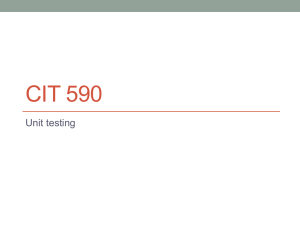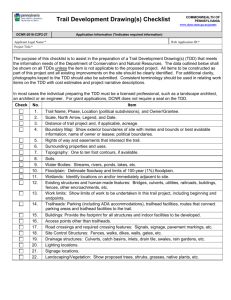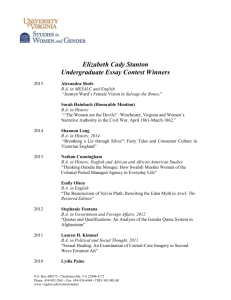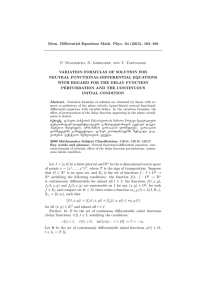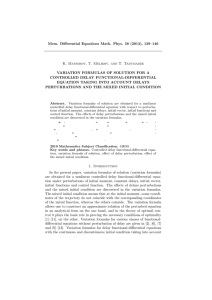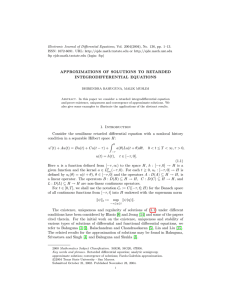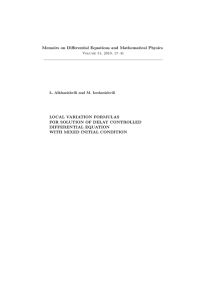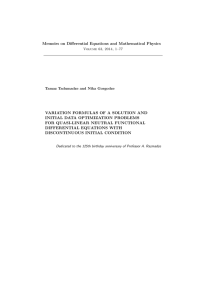Solution to Homework 1 - University of California, Davis
advertisement
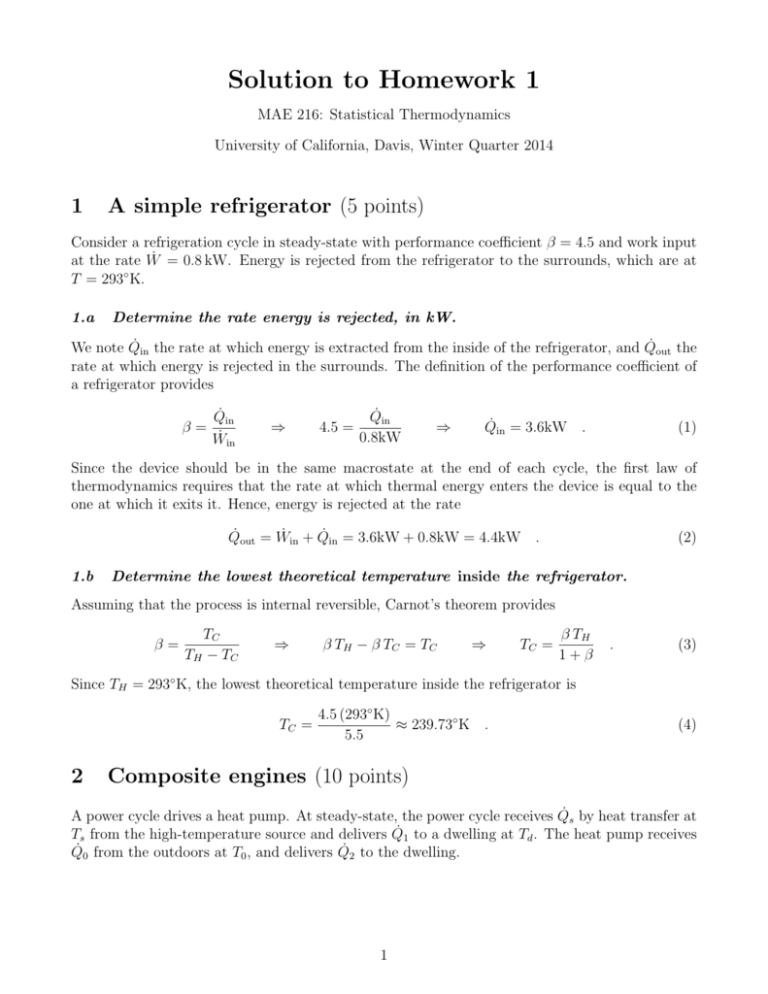
Solution to Homework 1 MAE 216: Statistical Thermodynamics University of California, Davis, Winter Quarter 2014 1 A simple refrigerator (5 points) Consider a refrigeration cycle in steady-state with performance coefficient β = 4.5 and work input at the rate Ẇ = 0.8 kW. Energy is rejected from the refrigerator to the surrounds, which are at T = 293◦ K. 1.a Determine the rate energy is rejected, in kW. We note Q̇in the rate at which energy is extracted from the inside of the refrigerator, and Q̇out the rate at which energy is rejected in the surrounds. The definition of the performance coefficient of a refrigerator provides β= Q̇in Ẇin ⇒ 4.5 = Q̇in 0.8kW ⇒ Q̇in = 3.6kW . (1) Since the device should be in the same macrostate at the end of each cycle, the first law of thermodynamics requires that the rate at which thermal energy enters the device is equal to the one at which it exits it. Hence, energy is rejected at the rate Q̇out = Ẇin + Q̇in = 3.6kW + 0.8kW = 4.4kW . 1.b (2) Determine the lowest theoretical temperature inside the refrigerator. Assuming that the process is internal reversible, Carnot’s theorem provides β= TC TH − TC ⇒ β TH − β TC = TC ⇒ TC = β TH 1+β . (3) Since TH = 293◦ K, the lowest theoretical temperature inside the refrigerator is TC = 2 4.5 (293◦ K) ≈ 239.73◦ K . 5.5 (4) Composite engines (10 points) A power cycle drives a heat pump. At steady-state, the power cycle receives Q̇s by heat transfer at Ts from the high-temperature source and delivers Q̇1 to a dwelling at Td . The heat pump receives Q̇0 from the outdoors at T0 , and delivers Q̇2 to the dwelling. 1 2.a Obtain an expression for the maximum theoretical value of the performance parameter (Q̇1 + Q̇2 )/Q̇s in terms of the temperature ratios Ts /Td and T0 /Td . Method I: As an extreme case of the second law. The rate at which heat enters the composite engine must balance the rate at which it exits it ⇒ Q̇0 + Q̇s = Q̇1 + Q̇2 Q̇0 = Q̇1 + Q̇2 − Q̇s . (5) The maximum theoretical value for the performance is obtained for a reversible engine, i.e., when the entropy remains unchanged 0= Q̇s Q̇0 Q̇1 Q̇2 + − − Ts T0 Td Td ⇒ Q̇1 + Q̇2 Q̇s Q̇0 Q̇s Q̇1 + Q̇2 − Q̇s = + = + Td Ts T0 Ts T0 Rearranging the terms gives 1 1 1 1 Q̇1 + Q̇2 = Q̇s − − Td T0 Ts T0 " #−1 " # Q̇1 + Q̇2 Ts T0 1 1 Ts T0 1 1 = − − Td Td T0 Td Ts T0 Q̇s Q̇1 + Q̇2 Ts /Td − T0 /Td = Ts /Td 1 − T0 /Td Q̇s . . (6) (7a) (7b) (7c) Equation (7c) is the sought relationship. Method II: As a power cycle driving a heat pump. For a power cycle, the maximal theoretical efficiency is ηmax = TH − TC Ẇout = TH Q̇in . (8) Noting Ẇ the work output rate from the power cycle (which is also the work input rate of the heat pump), we obtain Ts − Td Ẇ = Ts Q̇s ⇒ Ẇ = Q̇s (Ts − Td ) Ts . (9) For a heat pump, the maximal theoretical coefficient of performance is γmax = Q̇out TH = TH − TC Ẇin ⇒ Q̇2 Td = Td − T0 Ẇ . (10) Conservation of energy in the heat pump provides Q̇2 = Ẇ + Q̇0 while conservation of energy in the whole composite engine provides Q̇0 + Q̇s = Q̇1 + Q̇2 . Combining these relations gives Q̇2 = Ẇ + Q̇1 + Q̇2 − Q̇s , which we use together with equation (9) in equation (10) to obtain ! Td Ẇ + Q̇1 + Q̇2 − Q̇s Q̇1 + Q̇2 − Q̇s Ts Q̇2 Q̇1 + Q̇2 = = =1+ =1+ −1 . Td − T0 Ts − Td Ẇ Ẇ Q̇s (Ts − Td )/Ts Q̇s (11) 2 Isolating the sought ratio gives Isolating the sought ratio gives ◆ ✓ Td (T Q̇ + Q̇ T − T s−T d )) T d − ((T d−T 0 )) + 1 2 s d (T T T T T +T Tss(T (Tdd − T T00)) Q̇1 + Q̇2 = Ts Td Td − 1 + 1 = s d d d 0 = Ts 1 +1= T T Q̇ Ts Tdd − T T00 Tss(T (Tdd − T T00)) Q̇ss 2 2 Q̇ T T Q̇11 + + Q̇ Q̇22 = TssT T00 − T TddT T00 + +T TssT Tdd − TssT T00 = T TssT Tdd/T /Tdd2 − T TddT T00/T /Tdd2 = = Ts (Td − T0 )/T 22 T Q̇ Tss(T (Tdd − T T00)) Ts (Td T0 )/Tdd Q̇ss Q̇ T Q̇11 + + Q̇ Q̇22 = Tss/T /Tdd − T T00/T /Tdd = T Q̇ Tss/T /Tdd 11 − T T00/T /Tdd Q̇ss (12a) (12a) (12b) (12b) (12c) (12c) which is in agreement with equation (7c). 2.b Plot the results of 2.a versus Ts /Td ranging from 2 to 4 for T0 /Td = 0.85, 0.9, and 0.95. Performance parameter 15 T0 /Td = 0.85 T0 /Td = 0.90 10 T0 /Td = 0.95 5 0 2 2.5 3 3.5 4 Ts /Td 3 Ideal Gaz and Maxwell’s Relations (5+5 points) 3.a Starting from dU = T dS P dV , show that the equation of state P V = mRT in fact implies that U can only depend on T . In general, U (T, V, P ). However, due to the equation of state P V = mRT , only two of the three variables T , V and P are independent. Without loss of generality, we choose U (T, V ) = U (T, V, mRT ). All other thermodynamic functions thus also depend on T and V alone, e.g., S(T, V ). V We now calculate the total derivative of S(T, V ) dS = @S @S dT + dV @T V @V T (13) which we then use to calculate the total derivative of U (T, V ) dU = T dS @S @S P dV = T dT + T dV @T V @V T ✓ @S @S P dV = T dT + T @T V @V 3 3 P T ◆ dV . (14)

